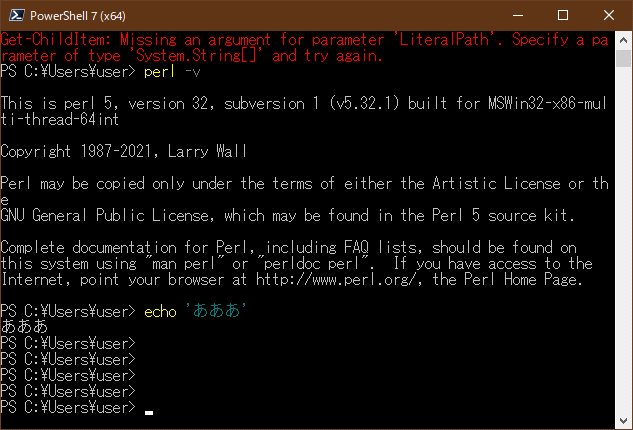PowerShell(pwsh) Tutorial for Perl
- Perl ›
- here
PowerShell(pwsh) is a CLI tool to run programs on Windows.
Features of PowerShell(pwsh)
- UTF-8
- Linux/UNIX-like Shell
- ls, echo commands, etc
- A string is quoted "" and ''
Installation of PowerShell(pwsh)
PowerShell(pwsh) can be downloaded from the following page.
Installing PowerShell on Windows
Click the following link to download PowerShell(pwsh).
And double-click the downloaded file. The installer is executed.
"Next" | "Next" | "Next" | "Install" | "Finish"
Execution of PowerShell/pwsh
Let's execute PowerShell/pwsh.
"Start Menu" | "Apps" | "PowerShell" | "PowerShell 7 (x64)"

Your home directory is shown on PowerShell/pwsh.
PS C:\Users\kimot
Showing File Extensions
The extension of Perl program is ".pl". It is useful if extensions of files are displayed.
The way to show file extensions is described in the following page.
How to Make Windows Show File Extensions
Execution of Notepad
Perl programs are text files. You can create your Perl programs using Notepad.
The way to use Notepad is described in the following page.
11 ways to start Notepad in Windows
Creating Perl Programs
Let's create a Perl program.
Create a file named "start.pl" at your home directory.
C:\Users\kimot\start.pl
And write the following text.
print "Hello World";
And save it.
Running Perl Programs
You can run your Perl program using perl command.
perl start.pl
The output is:
Hello World
Commands of PowerShell/pwsh
Introdule often used commands of PowerShell/pwsh.
ls
The "ls" command displays the list of files.
ls
cd
The "cd" command changes the working directory.
cd DirectoryName
".." is the file name that means the folder one level higher.
cd ..
Changing Drives
You can change drives using "c:" or "d:".
Set-Location -Path c: Set-Location -Path d:
Seeing Command Histories
You can see command histories using "↑" and "↓" keys.
↑ ↓
Show Environment Variables
Show environment variables.
ls env:
Getting Environment Variables
You can get and show an environment variable as the following.
echo $env:PATH
$env:MYENV = "This is my env."
Setting Environment Variable
You can set an environment variable as the following.
$env:DATE=20080604
 Perl ABC
Perl ABC